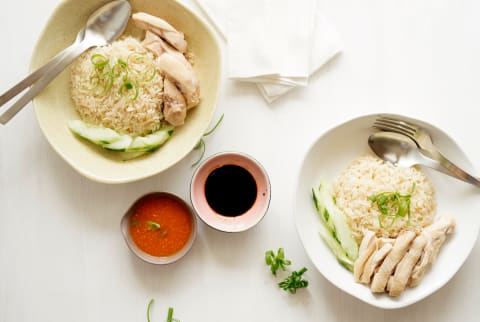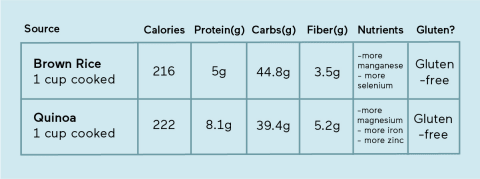Advertisement
Quinoa vs. Rice: Which Popular Grain Is Better For You?


Fiber-rich carbohydrates are a critical part of any diet, providing satiety, energy, and flavor to most meals. Rice, one of the most popular staple crops around the world, is often a go-to source of carbohydrates, but quinoa follows closely behind. Still, is one grain actually more nutritious than the other?
Health benefits of rice.
Broadly judging the health benefits of rice can be difficult since there are so many varieties: white, brown, wild, jasmine, basmati, the list goes on. In general, though, the author of Eat Your Vitamins and registered dietitian nutritionist Mascha Davis, MPH, RDN, says all types of rice can fit into a healthy diet. "Our bodies run on carbohydrates, and rice is an excellent way to meet your energy needs," she tells mbg.
Speaking of energy: White rice is a great option to eat before endurance exercise. "Simple carbs without a lot of extra insoluble fiber are the way to go the night before a race," Amy Shah, M.D., previously told mbg. Carbs with soluble fiber are harder to digest and may lead to an upset stomach during intense or prolonged exercise.
More nutritionally dense options for everyday eating include brown rice and black rice. "Black rice is one of the healthiest rice varieties, due in part to all the powerful antioxidants and phytonutrients (think the more intense the color, the higher in health-promoting nutrients)," certified culinary nutritionist and cookbook author Leah Vanderveldt writes for mbg. "It also contains fiber, iron, and copper along with protein."
How to use it: You can enjoy rice on its own or as a side to a protein like chicken, salmon, or tofu (here: a Japanese chef's guide to making the perfect rice). Davis also likes pairing rice with Asian-inspired meals, like congee or sushi.
Health benefits of quinoa.
Quinoa is actually a seed that acts like a grain when it's cooked, says certified dietitian and nutritionist Isabel Smith, R.D., CDN. While there are a few varieties (white, red, black, and tricolor), their nutritional value is relatively similar.
"It's gluten-free, high in protein, and contains nutrients like vitamin B, fiber, and various minerals (iron, calcium, zinc, and magnesium, to name a few) that boast a myriad of health benefits," Smith writes.
Registered dietitian Nour Zibdeh, M.S., RDN, calls quinoa one of the healthiest carbohydrates for blood sugar because of its high-protein and fiber content. Those nutrients also make it one of the best for boosting fullness and satiety, she adds.
How to use it: "Quinoa is great for things like grain bowls, salads, and even a breakfast porridge," Davis says. It can also be used as a substitute for rice in most dishes or served as a side.
Quinoa vs. brown rice nutrition.
While rice and quinoa can both be part of a healthy diet, the nutritional benefits of quinoa are slightly greater:

Quinoa is higher in protein than brown rice (8 grams compared to 3) and also high in fiber (5 grams compared to 1), says Ginger Hultin, RDN, spokesperson for the Academy of Nutrition and Dietetics.
These nutritional components make quinoa more filling and better for blood sugar balance, Davis explains.
The takeaway.
Though quinoa is a seed and rice is a grain, the two have a similar starchy flavor and fluffy texture and can often be used interchangeably in dishes. This makes it relatively easy to swap quinoa in place of rice. While they have similar nutrition profiles, overall quinoa has higher amounts of protein, fiber, as well as vitamins and minerals.
Watch Next
Enjoy some of our favorite clips from classes
Enjoy some of our favorite clips from classes
What Is Meditation?
Mindfulness/Spirituality | Light Watkins
Box Breathing
Mindfulness/Spirituality | Gwen Dittmar
What Breathwork Can Address
Mindfulness/Spirituality | Gwen Dittmar
The 8 Limbs of Yoga - What is Asana?
Yoga | Caley Alyssa
Two Standing Postures to Open Up Tight Hips
Yoga | Caley Alyssa
How Plants Can Optimize Athletic Performance
Nutrition | Rich Roll
What to Eat Before a Workout
Nutrition | Rich Roll
How Ayurveda Helps Us Navigate Modern Life
Nutrition | Sahara Rose
Messages About Love & Relationships
Love & Relationships | Esther Perel
Love Languages
Love & Relationships | Esther Perel
What Is Meditation?
Box Breathing
What Breathwork Can Address
The 8 Limbs of Yoga - What is Asana?
Two Standing Postures to Open Up Tight Hips
How Plants Can Optimize Athletic Performance
What to Eat Before a Workout
How Ayurveda Helps Us Navigate Modern Life
Messages About Love & Relationships
Love Languages
Advertisement

These Peanut Butter Cup Protein Bites Make The Perfect On-The-Go Snack
Molly Knudsen, M.S., RDN










